|
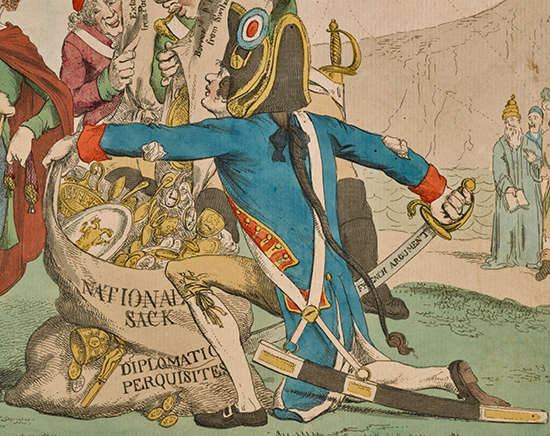
French Diplomacy 1797-1798
XYZ Affair
In a nutshell, the XYZ Affair was a major
crisis in the
diplomatic relations between the United States and France.
|
|
Image Above
The "French Argument" makes sure
that the National Sack is filled, collecting Diplomatic
Perquisites in the process.
Perquisites, by the way,
are any casual emolument, fee, or profit, attached to an
office or position in addition to salary or wages.
Detail from a British political
cartoon, published on June 1, 1798.
Library of Congress |
The situation deteriorated to
such an extent that the two countries fought an undeclared
naval war, mainly in the Caribbean Sea.
This military engagement is also
called the Quasi War.
The Background
On February 6, 1778, the U.S.
and France signed two treaties:
- a
Treaty of Alliance,
which agreed on a military coalition against
Great Britain, and
- a
Treaty of Amity and
Commerce
In the United States, a
pro-French / anti-Britain and an anti-French / pro-Britain sentiment emerged.
On April 22, 1793,
 President
Washington opted for a third option — neutrality.
President
Washington opted for a third option — neutrality.
The Proclamation of Neutrality 1793
A
Proclamation
Whereas
it appears that a state of war exists
between Austria, Prussia, Sardinia, Great
Britain, and the United Netherlands, of the
one part, and France on the other; and the
duty and interest of the United States
require, that they should with sincerity and
good faith adopt and pursue a conduct
friendly and impartial toward the
belligerent Powers;
I have therefore thought fit by these
presents to declare the disposition of the
United States to observe the conduct
aforesaid towards those Powers respectfully;
and to exhort and warn the citizens of the
United States carefully to avoid all acts
and proceedings whatsoever, which may in any
manner tend to contravene such disposition.
And I do hereby also make known, that
whatsoever of the citizens of the United
States shall render himself liable to
punishment or forfeiture under the law of
nations, by committing, aiding, or abetting
hostilities against any of the said Powers,
or by carrying to any of them those articles
which are deemed contraband by the modern
usage of nations, will not receive the
protection of the United States, against
such punishment or forfeiture; and further,
that I have given instructions to those
officers, to whom it belongs, to cause
prosecutions to be instituted against all
persons, who shall, within the cognizance of
the courts of the United States, violate the
law of nations, with respect to the Powers
at war, or any of them.
In testimony whereof, I have caused the seal
of the United States of America to be
affixed to these presents, and signed the
same with my hand. Done at the city of
Philadelphia, the twenty-second day of
April, one thousand seven hundred and
ninety-three, and of the Independence of the
United States of America the seventeenth.
George
Washington
April 22, 1793
Source: The
Avalon Project
 Check this event in the timeline of
the French Revolutionary Wars
Check this event in the timeline of
the French Revolutionary Wars
On November 19, 1794, the
 Jay
Treaty was signed between the U.S. and Great
Britain. This treaty was formally called the
Treaty of Amity, Commerce and
Navigation, and the French weren't amused.
Jay
Treaty was signed between the U.S. and Great
Britain. This treaty was formally called the
Treaty of Amity, Commerce and
Navigation, and the French weren't amused.
On July 2, 1796, France issued a law by which it legalized
the confiscation of neutral American merchant ships.
Tension grew. The diplomatic relations between the U.S. and France
declined. If war was to be avoided, something had to be done.
The Attempt to
Mend Diplomatic Relations
|
As the
President of the Unites States,
 John Adams
was inclined
to continue Washington's neutral
approach.
John Adams
was inclined
to continue Washington's neutral
approach.
Adam's
vice president,
 Thomas Jefferson,
was very much pro-France, however.
Thomas Jefferson,
was very much pro-France, however.
In
1797, President Adams sent a group of
three diplomats to France, in order
to negotiate maritime rights for
commercial U.S. shipping as well as
compensation for confiscated goods
and captured vessels. |
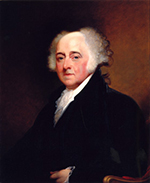 |
|
John Adams
U.S. President 1797-1801 |
These 3
diplomats were Elbridge Gerry,
John
Marshall, and
Charles Cotesworth Pinckney,
Envoys Extraordinary and Ministers
Plenipotentiary from the United States of
America to the French Republic.
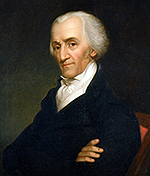 |
|
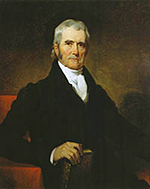 |
|
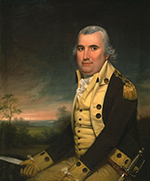 |
Elbridge Gerry
(1744-1814) |
|
John Marshall
(1755-1835) |
|
Charles Cotesworth Pinckney
(1746-1825) |
Their goal was,
of course, trying to meet with the French
Minister of Foreign Affairs,
 Charles-Maurice de Talleyrand.
Charles-Maurice de Talleyrand.
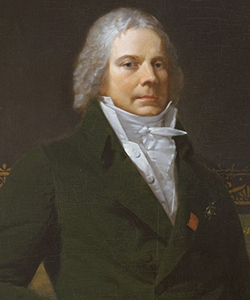
Charles-Maurice de Talleyrand
Now...
The
XYZ Affair Unfolds
In October 1797,
the U.S. diplomats arrived at Paris, but Talleyrand
refused to receive them.
Instead,
they were approached by 4
French diplomats —
Nicholas Hubbard,
Jean Hottinguer,
Pierre Bellamy, and
Lucien Hauteval
— who in diplomatic correspondence were
later referred to
as W, X, Y, and Z.
Thus, to be exact, the XYZ Affair was actually the WXYZ
affair.
 |
|
 |
|
 |
|
 |
|
Nicholas Hubbard (W) |
|
Jean Hottinguer (X) |
|
Pierre Bellamy (Y) |
|
Lucien Hauteval (Z) |
What message did
the French diplomats carry?
It boiled down to
this:
Talleyrand would
be willing to meet and to negotiate with the
Americans if
- the United
States would grant France a loan
- the United
States would step back from and take care of
American merchant claims against France
- Talleyrand
would be given a decent personal bribe
Recent Events in
France
Just a quick reminder of some of the
recent key events in France, to put the XYZ Affair into its proper
historical context:
On July 14, 1789, a Paris mob stormed the
 Bastille, which was the
beginning of the
Bastille, which was the
beginning of the
 French
Revolution. French
Revolution.
On September 21, 1792, France formally
abolished the monarchy and became a Republic.
On January 21, 1793, the French
guillotined their former
 King Louis XVI.
King Louis XVI.
By October 1797, when the American diplomats arrived, France was led
by the
 Directory.
(See also Directory.
(See also
 Governments
of France) Governments
of France)
And on October 17, 1797, the French
had just signed the
 Treaty of Campo Formio which
declared France the victor of the
Treaty of Campo Formio which
declared France the victor of the
 War of the First Coalition.
War of the First Coalition.
The Response
Besides being utterly outraged, the
U.S. delegation had serious doubts that any compliance with the
French demands would help the original issue (French-American agreement
on international commercial shipping rights) in the long run.
The American envoys did not comply.
Talleyrand, seeing that he had gotten
nowhere with his stipulations, finally met with the U.S. diplomats. But for him, it was out of the
question to leave American ships be.
That was it for Pinckney and Marshall, who decided to pack their bags and
called a cab for their trip to the airport. Interestingly, Gerry stayed put.
Back in the States
Consequently, President Adams prepared
for war. To justify his decision, he had to release documentation of
this diplomatic incident, which he did in April 1798, and in which
he replaced the names of the French diplomats with W, X, Y, and Z.
I will never send another minister to France
without assurances that he will be received,
respected, and honored as the representative
of a great, free, powerful, and independent
nation.
John Adams
June 21, 1798
Message to the Senate and
House
An undeclared naval war ensued.
The Quasi-War
The Quasi War was fought from July 7,
1798, until September 30, 1800.
The U.S. Navy captured more than 80
French ships.
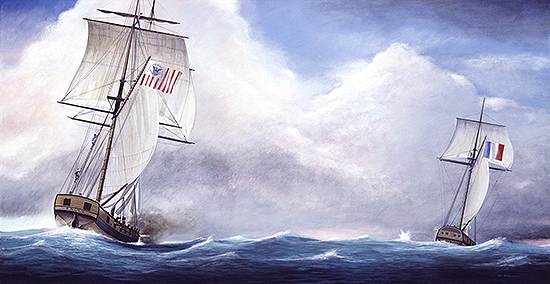
The Revenue Cutter
Eagle Chases and Captures the French Sloop Bon Pere
Near Antigua, Caribbean - April 1799
The Eagle, so tells us
the U.S. Coast Guard, was the most successful of the
revenue cutters. It captured ten French vessels and retook four
American prizes.
Painting by Wendell Minor
Talleyrand saw it fit to kiss up and
let it be known that France was ready to receive U.S. diplomats. This
time for real.
On September 30, 1800, the
Treaty of
Morfontaine, also called the Treaty of Friendship and
Commerce, was concluded between the United States and France.
This was the end of the Quasi-War.
Whatever Happened to Gerry,
Marshall, and Pinckney?
Gerry was criticized in abundance for staying in
Paris after Marshall and Pinckney had left. In 1810, he became
governor of Massachusetts. In 1812, he was elected vice president of
the United States under
 President James Madison.
President James Madison.
Marshall became the fourth Chief Justice of the
United States on February 4, 1801, and served as such for 34 years.
The Superintendent of the U.S. Government Printing Office tells us,
Under
Marshall, the Supreme Court emerged as a
prestigious, powerful, and equal third
branch of the government. By defining the
role of the Court in a number of pioneering
decisions, Marshall set forth the principles
by which the Constitution is still
interpreted today. He emphasized national
supremacy over the interests of the
individual states, as well as the protection
of property rights.
In 1819, Marshall wrote,
The
Constitution is intended to endure for ages to come, and
consequently, to be adapted to the various crises of human affairs.
A former soldier, Pinckney ran for
president, losing in 1804 to Thomas Jefferson, and in 1808 to James
Madison. He then worked as a lawyer in his hometown Charleston,
South Carolina.
More History
|